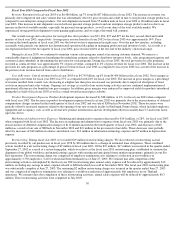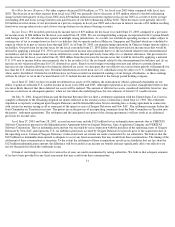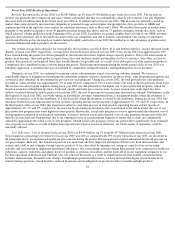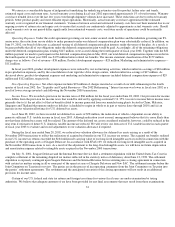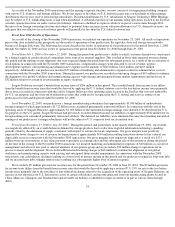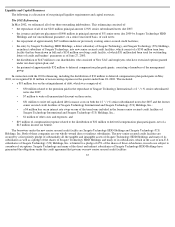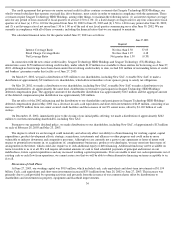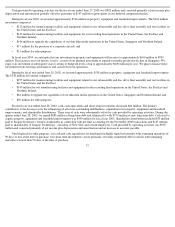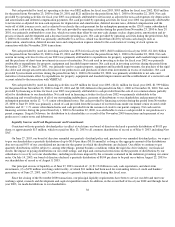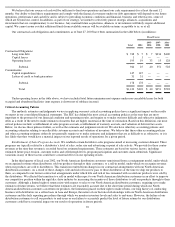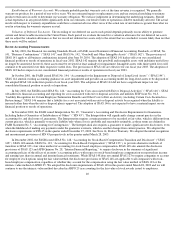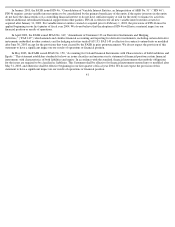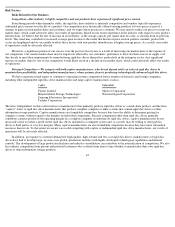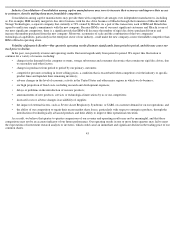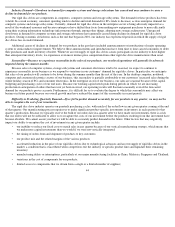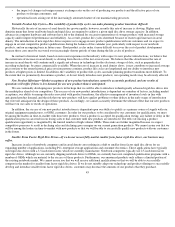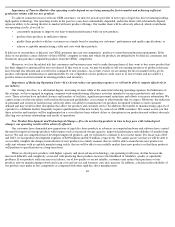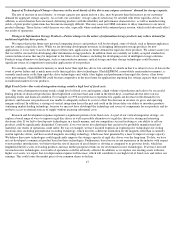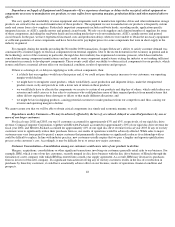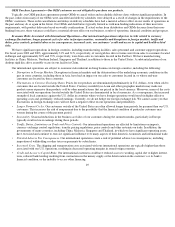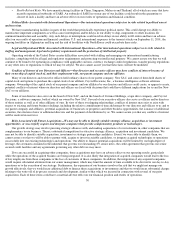Seagate 2002 Annual Report Download - page 45
Download and view the complete annual report
Please find page 45 of the 2002 Seagate annual report below. You can navigate through the pages in the report by either clicking on the pages listed below, or by using the keyword search tool below to find specific information within the annual report.
Establishment of Warranty Accruals. We estimate probable product warranty costs at the time revenue is recognized. We generally
warrant our products for a period of one to five years. We use estimated repair or replacement costs and use statistical modeling to estimate
product return rates in order to determine our warranty obligation. We exercise judgement in determining the underlying estimates. Should
actual experience in any period differ significantly from our estimates, our future results of operations could be materially affected. The actual
results with respect to warranty expenditures could have a material adverse effect on us if the actual rate of unit failure is greater than what we
used in estimating the warranty expense accrual.
Valuation of Deferred Tax Assets . The recording of our deferred tax assets each period depends primarily on our ability to generate
current and future taxable income in the United States. Each period we evaluate the need for a valuation allowance for our deferred tax assets
and we adjust the valuation allowance so that we record net deferred tax assets only to the extent that we conclude it is more likely than not that
these assets will be realized.
Recent Accounting Pronouncements
In July 2001, the Financial Accounting Standards Board, or FASB, issued Statement of Financial Accounting Standards, or SFAS, No.
141, “Business Combinations” (“SFAS 141”) and SFAS No. 142, “Goodwill and Other Intangible Assets” (“SFAS 142”). The provisions of
SFAS 141 apply to all business combinations initiated after June 30, 2001. The adoption of SFAS 141 had no effect on our consolidated
financial position or results of operations in fiscal year 2002. SFAS 142 requires that goodwill and intangible assets with indefinite useful lives
no longer be amortized; however, these assets must be reviewed at least annually for impairment. Intangible assets with finite useful lives will
continue to be amortized over their respective useful lives. The provisions of SFAS 142 are effective for our fiscal year 2003. The adoption of
SFAS 142 had no impact on our consolidated financial position or results of operations in fiscal year 2003.
In October 2001, the FASB issued SFAS No. 144, “Accounting for the Impairment or Disposal of Long-Lived Assets” (“SFAS 144”).
SFAS 144 amends existing accounting guidance on asset impairment and provides an accounting model for long-lived assets to be disposed of.
We adopted SFAS 144 in the first quarter of our fiscal year 2003. The adoption of SFAS 144 did not have a significant impact on our
consolidated financial position or results of operations.
In July 2002, the FASB issued SFAS No. 146, “Accounting for Costs Associated with Exit or Disposal Activities” (“SFAS 146”). SFAS
146 addresses financial accounting and reporting for costs associated with exit or disposal activities and nullifies EITF Issue No. 94-3,
“Liability Recognition for Certain Employee Termination Benefits and Other Costs to Exit an Activity (including Certain Costs Incurred in a
Restructuring).” SFAS 146 requires that a liability for a cost associated with an exit or disposal activity be recognized when the liability is
incurred rather than when the exit or disposal plan is approved. The adoption of SFAS 146 is not expected to have a material impact on our
financial position or results of operations.
In November 2002, the FASB issued Interpretation No. 45, “Guarantor’s Accounting and Disclosure Requirements for Guarantees,
Including Indirect Guarantees of Indebtedness of Others” (“FIN 45”). The Interpretation will significantly change current practice in the
accounting for, and disclosure of, guarantees. The Interpretation requires certain guarantees to be recorded at fair value, which is different from
current practice, which is generally to record a liability only when a loss is probable and reasonably estimable, as those terms are defined in
FASB Statement No. 5, “Accounting for Contingencies”.
The Interpretation also requires a guarantor to make significant new disclosures, even
when the likelihood of making any payments under the guarantee is remote, which is another change from current practice. We adopted the
disclosure requirements of FIN 45 in the quarter ended December 27, 2002. See Note 14, Product Warranty. We adopted the initial recognition
and measurement provisions of FIN 45 prospectively in the quarter ended March 28, 2003.
In December 2002, the FASB issued SFAS No. 148, “Accounting for Stock-Based Compensation Transition and Disclosure” (“SFAS
148”). SFAS 148 amends SFAS No. 123, “Accounting for Stock-Based Compensation” (“SFAS 123”), to provide alternative methods of
transition to SFAS 123’s fair value method of accounting for stock-based employee compensation. SFAS 148 also amends the disclosure
provisions of SFAS 123 and APB Opinion No. 28, “Interim Financial Reporting,” to require disclosure in the summary of significant
accounting policies of the effects of an entity’s accounting policy with respect to stock-based employee compensation on reported net income
and earnings per share in annual and interim financial statements. While SFAS 148 does not amend SFAS 123 to require companies to account
for employee stock options using the fair value method, the disclosure provisions of SFAS 148 are applicable to all companies with stock-
based employee compensation, regardless of whether they account for the compensation using the fair value method of SFAS 123 or the
intrinsic value method of APBO 25. We adopted the disclosure requirements of SFAS 148 in the quarter ended March 28, 2003 and we will
continue to use the intrinsic value method described in ABPO 25 in accounting for the fair value of stock awards issued to employees.
40


